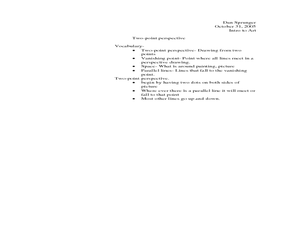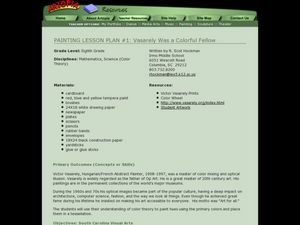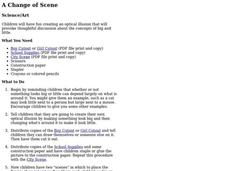Curated OER
Geometric Optic Spinner
Students investigate the concept of an optical illusion and how they are used. They conduct an information search of how the eye works. The information is used in order to set the context upon the creation of a personal optical illusion.
Curated OER
Optical Illusion Vase
Learners draw an optical illusion. In this optical illusion instructional activity, students create the optical illusion vase. Learners draw a profile and repeat the drawing in reverse creating the vase image.
Curated OER
Intro to Art
Students explore illusions by drawing and viewing images in class. In this art perspective lesson, students analyze a skeleton outline drawing which demonstrates the ability to draw in a two point perspective. Students utilize the...
University of Minnesota
Beautiful Brain: Do You See What I See?
Can art play tricks on your eyes, and can a still painting really appear to vibrate? The second lesson in a four-part series discusses the way our beautiful brains translate visual images. It highlights the style of optical art and...
Curated OER
Op Art and Contrast
Seventh graders explore the Op art movement and the work of artists Bridget Riley, Victor Vasarely and MC Escher. the principles of contrast and how it can be used to create optical illusions is examined in this lesson.
National Gallery of Canada
My Upside-Down World!
M.C. Escher is famous for creating optical illusions. Examine this effect in several of his works and discuss the techniques involved. Inspired by the discussion, learners create an imaginary 3-D world inside of a box using various...
Curated OER
Exploring Optical Movement in Art
Students describe, represent and analyze patterns and relationships using shapes. They create simple geometric patterns. They demonstrate increasing technical ability and skill to complete visual arts assignments.
Curated OER
Fraggle Monster Vase
Students create an optical illusion. In this optical illusions instructional activity, students sketch a monster's face to create the optical illusion of a vase in the positive space. Students create an original piece of art.
Curated OER
Vasarely Was A Colorful Fellow
Eighth graders create artwork inspired by the work of Victor Vasarely. In this op art lesson, 8th graders explore color theory and color mixing. Students create ten shapes to use in their artwork and over the course of two weeks,...
Curated OER
Op Art and Contrast
Seventh graders create Op art designs by reading web information through FlingIt, mapping learned concepts with PicoMap, and creating how-to examples of their own Op art design by using Sketchy. They complete the activity by creating...
Wake County Public Schools
Language
Have your class doing everything from reading literature, analyzing literary devices, identifying independent and dependent clauses, discussing, and writing creatively with the rich resource found here. After a mini lesson on independent...
Curated OER
Psychedelic Checkerboard Op Art
Students analyze optical illusions from the packets, both individually and as a class. They create an original optical illusion design using pattern and repetition. They determine which color needs to be in the pattern.
Curated OER
A Change of Scene
Students create their own optical illusions by making something look big and then changing what's around it to make it look little.
Curated OER
A Change of Scene
Students are challenged to create optical illusions using using cut-outs. The activity provokes thoughtful discussion about scale.
Curated OER
Anamorphosis
Students classify optical illusions according to their distinguishing characteristics. They create anamorphic art and use Mylar flexible mirrors to view and then they describe and analyze the optical illusion.
Curated OER
Open Your Eyes To Art!
Students help create a colorful bulletin board for classroom art displays in this short lesson for the early elementary classroom. The lesson, which can use a variety of items, includes product ideas and resource links to find very...
Curated OER
Op Art Circles
Students create Optical Art, art that seems to move when you look at it, in this Art instructional activity for the High School classroom. Included with the instructional activity is a list of recommended materials and suggested resource...
Curated OER
Who Ever Heard Of Red Shamrocks?
Students discover optical illusions in this lesson that uses a red shamrock and white construction paper. Emphasis is placed upon inquiry, experiment, and then a short discussion on optical illusions and complimentary colors.
Curated OER
Dot To Dot Seurat
Students discuss the art of Georges Seurat and examples of Pointillism and create original works of Pointillism using colored, sticker dots. This lesson is intended for use in the elementary Art classroom and includes a short vocabulary...
Curated OER
Dot To Dot Seurat
Students explore the style of art known as pointillism and the artist (Georges Seurat) who created it.
Curated OER
Does Negative Space Have A Shape?
Students observe negative space in drawing. In this negative space lesson, students discover that sketches include negative space or background. Students produce a drawing while paying attention to the negative space.
Curated OER
Would You Believe Your Eyes?
Students study the parts and functions of the human eye. They create dodecagons which are twelve-sided figures with twelve equal angles and share these with the class so that each student can begin to see how many different illusions can...
Curated OER
Does It Look All Right to Me?
Students identify different viewpoints in society. They describe the characteristics of some of the individuals involved in the march from Selma to Montgomery, Alabama. They listen to a historical narrative and identify issues of...
Curated OER
Does It Looks All Right to Me?
Students explore the concept of philanthropy. In this service learning lesson plan, students examine the accomplishments of Civil Rights leaders' as works of philanthropy. Students read literature regarding diversity and study the Selma...

























